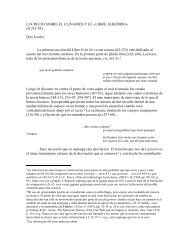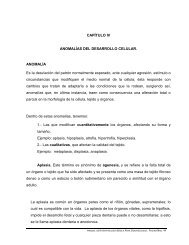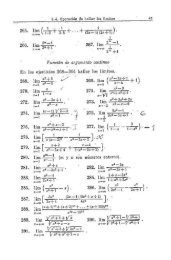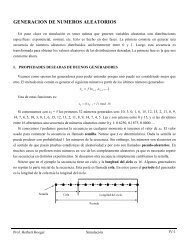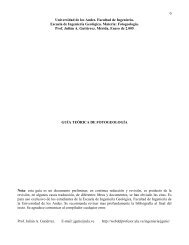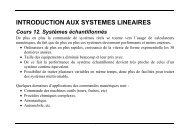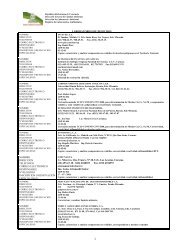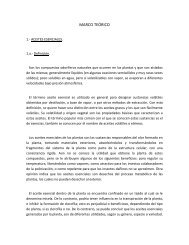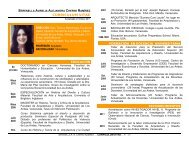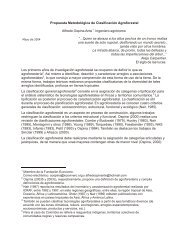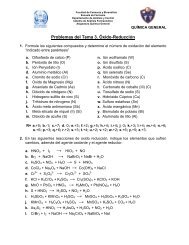Macrocyclic Ligands - Web del Profesor
Macrocyclic Ligands - Web del Profesor
Macrocyclic Ligands - Web del Profesor
Create successful ePaper yourself
Turn your PDF publications into a flip-book with our unique Google optimized e-Paper software.
HO O O OH<br />
+<br />
Cl O O Cl<br />
Scheme 9<br />
Spherands and hemispherands (21)and(22) are synthesized<br />
by ring closure reactions of aryllithium with Fe(acac)3, often<br />
using high dilution techniques. 36<br />
Calixarenes (23) are obtained from base-catalyzed condensations<br />
of p-substituted phenols with formaldehyde. 37<br />
4 THERMODYNAMICS AND STRUCTURAL<br />
ASPECTS<br />
4.1 Introduction<br />
4.1.1 The <strong>Macrocyclic</strong> Effect<br />
This term refers to the amazing stability of macrocyclic<br />
ligands. It was initially described in studies of tetraaza<br />
macrocycles with copper(II). 63 For polyaza macrocycles this<br />
effect has been attributed to both entropic and enthalpic<br />
considerations and considerable controversy raged for a<br />
number of years as to which was the predominant factor. 64,65<br />
The conflicting reports are now realized to be extremely<br />
dependent on the experimental methods used for the<br />
determination of the thermodynamic parameters. Two main<br />
types of technique have been employed, each of which has its<br />
strengths and weaknesses: the calorimetric titration method<br />
and the use of the temperature variation of the stability<br />
constants. The controversy has been largely settled by more<br />
recent studies. 66,67 Important contributions to the enthalpic<br />
term are now attributed to a number of factors, including<br />
solvation and conformation changes upon bond formation.<br />
Likewise, the entropic considerations include the number of<br />
species present and particularly solvation effects. Detailed<br />
discussions of the historical development can be found. 13,17<br />
Related to the macrocyclic effect are the decreased rates<br />
of dissociation observed for macrocyclic complexes. Busch<br />
and co-workers have coined a term to describe these longterm<br />
stabilities incurred by synthetic macrocycles: multiple<br />
juxtapositional fixedness. The premise is that straight-chain<br />
ligands can undergo dissociative displacements in consecutive<br />
steps starting at one end of the ligand and finishing with the<br />
opposite end. This is not the case for macrocyclic ligands, for<br />
which each dissociated donor is still held in proximity to the<br />
metal ion by the rest of the ligand framework. 68<br />
O<br />
O<br />
O<br />
O<br />
O<br />
O<br />
MACROCYCLIC LIGANDS 9<br />
The macrocyclic effect has been observed for polyaza,<br />
polythia, and polyoxa, as well as mixed donor atom,<br />
macrocycles. 69<br />
4.1.2 Selectivity<br />
The selectivity of a macrocycle for either a metal ion or<br />
another substrate is critically dependent on the structure of<br />
the macrocycle and electronic effects, i.e. the types of donor<br />
atoms. Some of the important aspects are described below.<br />
1. The number of binding sites is perhaps one of the<br />
most crucial influences on the binding properties of the<br />
substrate. Electronic effects of the binding of macrocycles<br />
with substrates are charge, polarity, and polarizability<br />
of the binding sites. For metal ion binding, this means<br />
ion pair interactions for negatively charged ligands,<br />
ion–dipole and ion–induced dipole interactions for<br />
neutral ligands, and the hard–soft acid–base criteria.<br />
Nitrogen, phosphorus, and sulfur donors are noted for<br />
their complexation of transition metal ions. Oxygen is<br />
more likely to complex alkali or alkaline earth metal ions.<br />
2. The arrangement of the binding sites should be such as to<br />
maximize the potential ligand–metal ion interactions. In<br />
this regard the selection of spacers between donor atoms<br />
to allow for the formation of five- and six-member chelate<br />
rings has been the most utilized.<br />
3. The preferred conformations of the macrocycles dictate<br />
its propensity to bind a metal ion internally or externally<br />
to the cavity. The propensity of the lone pair to point in<br />
or out of the cavity is also a deciding factor. Hence, it is<br />
not always a foregone conclusion that the metal ion will<br />
be bound within the macrocyclic cavity.<br />
4. The identity of the macrocyclic framework also plays<br />
a major role in structure. For example, saturated<br />
hydrocarbon chains provide considerably more flexibility<br />
than incorporated aromatic units. Likewise the presence<br />
of other functional groups, such as amides or esters, serve<br />
to stiffen the macrocyclic framework. Decreasing the<br />
flexibility of the macrocycle by adding selected ‘shaping<br />
groups’ is the theory behind preorganization, so important<br />
in the cavitands. Another method of creating rigidity is to<br />
increase the dimensionality of the macrocycle, inherent in<br />
cryptand selectivities.<br />
5. The size of the macrocyclic cavity also plays a large role in<br />
governing the flexibility of the ligand, and its propensity<br />
for metal ion binding.<br />
Since the focus of this article is primarily on transition metal<br />
chemistry, the structural aspects related to complexation of<br />
transition metals will be emphasized, and other aspects of<br />
complexation will only be briefly treated.<br />
In addition to the traditional measurement of thermochemical<br />
properties, molecular mechanics calculations are now<br />
available to supplement and correlate with experimental findings.<br />
An extensive review which links the large data base of



